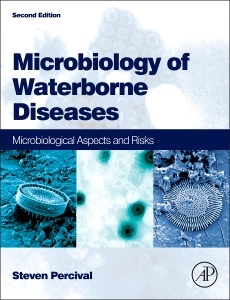Microbiology of Waterborne Diseases (2nd Ed.) Microbiological Aspects and Risks
Coordonnateurs : Percival Steven L., Yates Marylynn V., Williams David, Chalmers Rachel, Gray Nicholas

The second edition of Microbiology of Waterborne Diseases describes the diseases associated with water, their causative agents and the ways in which they gain access to water systems. The book is divided into sections covering bacteria, protozoa, and viruses. Other sections detail methods for detecting and identifying waterborne microorganisms, and the ways in which they are removed from water, including chlorine, ozone, and ultraviolet disinfection.
The second edition of this handbook has been updated with information on biofilms and antimicrobial resistance. The impact of global warming and climate change phenomena on waterborne illnesses are also discussed. This book serves as an indispensable reference for public health microbiologists, water utility scientists, research water pollution microbiologists environmental health officers, consultants in communicable disease control and microbial water pollution students.
Chapter 1 Waterborne Pathogens and Biofilms
PART 2 BACTERIOLOGY
Chapter 2 Acinetobacter
Chapter 3 Aeromonas
Chapter 4 Campylobacter
Chapter 5 Cyanobacteria
Chapter 6 Escherichia coli
Chapter 7 Helicobacter pylori
Chapter 8 Legionella
Chapter 9 Mycobacterium avium complex
Chapter 10 Salmonella
Chapter 11 Shigella
Chapter 12 Vibrio
Chapter 13 Yersinia
PART 3 PROTOZOA
Chapter 14 Acanthamoeba
Chapter 15 Balantidium
Chapter 16 Cryptospridium
Chapter 17 Cyclospora
Chapter 18 Entamoeba
Chapter 19 Giardia
Chapter 20 Naegleria
Chapter 21 Toxoplasma
PART 4 VIRUSES
Chapter 22 Methods to Detect Viruses
Chapter 23 Adenovirus
Chapter 24 Astrovirus
Chapter 25 Enterovirus
Chapter 26 Hepatitis
Chapter 27 Norovirus
Chapter 28 Rotavirus
PART 5 CONTROL
Chapter 29 Pathogen control in drinking water
Chapter 30 Free and combined chlorine
Chapter 31 Chlorine dioxide
Chapter 32 Ozone disinfection
Chapter 33 Ultraviolet Disinfection
Chapter 34 Filtration methods
PART 6 GLOBAL WARMING
Chapter 35 The implications of global warming and Climate Change on waterborne diseases
- Focuses on the microorganisms of most significance to public health, including E. coli, cryptosporidium, and enterovirus
- Highlights the basic microbiology, clinical features, survival in the environment, and gives a risk assessment for each pathogen
- Contains new material on antimicrobial resistance and biofilms
- Covers drinking water and both marine and freshwater recreational bathing waters
Date de parution : 11-2013
Ouvrage de 696 p.
18.8x24.6 cm
Disponible chez l'éditeur (délai d'approvisionnement : 14 jours).
Prix indicatif 165,11 €
Ajouter au panierThèmes de Microbiology of Waterborne Diseases :
Mots-clés :
biofilm; pathogens; attachment; stress resistance; disinfection; heterogeneity; fitness; infectivity; pathogenicity; internalization; Acinetobacter; natural history; skin; antimicrobial; biofilm; virulence; nosocomial; water; persistent infection; transmission routes; disinfection resistance; oocysts; disease burden; toxoplasmosis; genetic variation; waterborne outbreaks; adsorption/elution; entrapment; hydroextraction; ultra-centrifugation; plaque assay; liquid assay; most probable number assay; e



